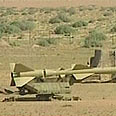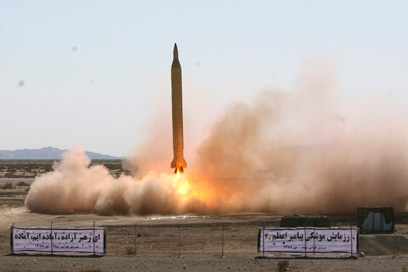
Iran tests most advanced missiles
Fars news agency reports Revolutionary Guard successfully tests upgraded versions of Shahab-3, Sajjil missiles, both capable of reaching Israel and US bases in Mideast. Defense Minister Vahidi says Israeli attack will 'expedite Zionist regime's last breath.' UK: This sends wrong signal to international community at a time when Iran is due to meet six world powers
Iran tested its most advanced missiles Monday to cap two days of war games, raising more international concern and stronger pressure to quickly come clean on the newly revealed nuclear site Tehran was secretly constructing.
State television said the powerful Revolutionary Guard, which controls Iran's missile program, successfully tested upgraded versions of the medium-range Shahab-3 and Sajjil missiles. Both can carry warheads and reach up to 1,200 miles (2,000 kilometers), putting Israel, US military bases in the Middle East, and parts of Europe within striking distance.
The missile tests were meant to flex Iran's military might and show readiness for any military threat.
"Iranian missiles are able to target any place that threatens Iran," said Abdollah Araqi, a top Revolutionary Guard commander, according to the semi-official Fars news agency.
Shortly after Iran test fired the missiles, Defense Minister Ahmad Vahidi warned Israel against carrying out any attack against Iran, saying it would only accelerate the Jewish state’s own demise.
“We do not foresee an attack by the Zionist regime, but if this happens, undoubtedly it would accelerate this regime’s last breath, and would bring its life to an end sooner,” he was quoted by the state-run broadcaster, IRIB, as saying.
Vahidi said that Israel’s threats against the Islamic Republic were due to “its widespread fear and alarm.”
“The Zionist regime is on a downward slope,” Vahidi added, echoing remarks frequently made by Iranian President Mahmoud Ahmadinejad.
The head of Iran's armed forces, Hassan Firouzabadi, dismissed reports of a possible attack on Iran, saying Israel was a "paper tiger."
"When people say Israel is planning on attacking Iran – this is nothing more than deception," he said, adding, "The US is funding Israel from its taxpayers' money and is uneasy due to the fact that Iran is capable of dealing a crushing retaliatory blow."
Firouzabadi added that despite sanctions imposed on Iran's military industry by the West, "the Revolutionary Guard can produce any weapon it chooses."
Iran conducted three rounds of missile tests in drills that began Sunday, two days after the US and its allies disclosed the country had been secretly developing an underground uranium enrichment facility. The Western powers warned Iran it must open the site to international inspection or face harsher international sanctions.

Shahab-3 missile test (Photo: AP)
Iran's Foreign Ministry spokesman Hasan Qashqavi said the missile tests had nothing to do with the tension over the site, saying it was part of routine, long-planned military exercises.
European Union foreign policy chief Javier Solana said he was concerned about the missile tests. He said Iran must immediately resolve issues surrounding its second nuclear enrichment facility with the UN's nuclear agency.
The newly revealed nuclear site has given greater urgency to a key meeting on Thursday in Geneva between Iran and six major powers trying to stop its suspected nuclear weapons program. Solana said those talks are now taking place "in a new context."
Britain said Monday's test further illustrates why Europe and the US have serious concerns about Iran's nuclear intentions.
"This sends the wrong signal to the international community at a time when Iran is due to meet" the six world powers, Britain's Foreign Office said. The six nations are the US, Britain, France, Russia, China and Germany.
Pentagon spokesman Bryan Whitman called the tests "troublesome."
"You combine these show-of-force type missile tests along with the other revelations that have been brought to light over the last couple of days with their continued development of a nuclear program, and you put all those together, and it paints a picture of ... a pattern of deception," Whitman said.
He added that the United States and other nations were focused on the talks "to see if there is a way forward diplomatically and, if not, then what the next steps might be."
Technological breakthrough
US Secretary of State Hillary Rodham Clinton said she doesn't believe Iran can convince the US and other world powers at the upcoming meeting that its nuclear program is for peaceful purposes, as Tehran has long claimed. That puts Tehran on a course for tougher economic penalties beyond the current "leaky sanctions," she said.
The nuclear site is located in the arid mountains near the holy city of Qom and is believed to be inside a heavily guarded, underground facility belonging to the Revolutionary Guard, according to a document sent by President Barack Obama's administration to lawmakers.
Qashqavi, the Foreign Ministry spokesman, identified the site as Fordo, a village located 110 miles (180 kilometers) south of the capital, Tehran. The site is 60 miles (100 kilometers) from Natanz, Iran's known industrial-scale uranium enrichment plant.
After strong condemnations from the US and its allies, Iran said Saturday it will allow UN nuclear inspectors to examine the site.
Israel has trumpeted the latest discoveries as proof of its long-held assertion that Iran is seeking nuclear weapons.
By US estimates, Iran is one to five years away from having nuclear weapons capability, although US intelligence also believes that Iranian leaders have not yet made the decision to build a weapon.
Iran also is developing ballistic missiles that could carry a nuclear warhead, but the administration said last week that it believes that effort has been slowed. That assessment paved the way for Obama's decision to shelve the Bush administration's plan for a missile shield in Europe, which was aimed at defending against Iranian ballistic missiles.
The Sajjil-2 missile is Iran's most advanced two-stage surface-to-surface missile and is powered entirely by solid-fuel while the older Shahab-3 uses a combination of solid and liquid fuel in its most advanced form, which is also known as the Qadr-F1.
Solid fuel is seen as a technological breakthrough for any missile program as solid fuel increases the accuracy of missiles in reaching targets.
Experts say Sajjil-2 is more accurate than Shahab missiles and its navigation system is more advanced.
State media reported tests overnight of the Shahab-1 and Shahab-2 missiles, with ranges of 185 miles (300 kilometers) and 435 miles (700 kilometers) respectively.
That followed tests early Sunday of the short range Fateh, Tondar and Zelzal missiles, which have a range of 120 miles (193 kilometers), 93 miles (150 kilometers) and 130 miles (200 kilometers) respectively.
Iran's last known missile tests were in May when it fired its longest-range solid-fuel missile, Sajjil-2. Tehran said the two-stage surface-to-surface missile has a range of about 1,200 miles (1,900 kilometers) — capable of striking Israel, US Mideast bases and southeastern Europe.










